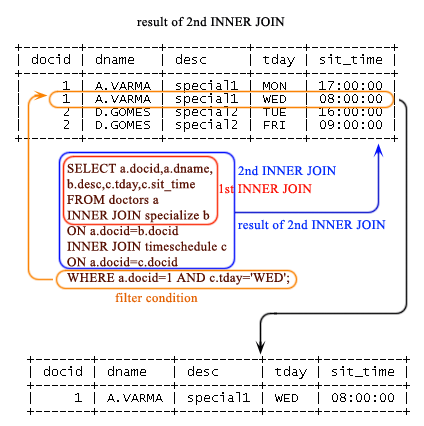
This Oracle tutorial explains how to use JOINS (inner and outer) in Oracle with syntax, visual illustrations, and examples. Oracle JOINS are used to retrieve data from multiple tables. Summary: in this tutorial, you will learn how to use the Oracle LEFT JOIN clause to query data from multiple tables. Introduction to Oracle LEFT JOIN clause. One other detail to note: the behaviour of the old-style Informix OUTER join under filter conditions is not the same as the behaviour of Standard SQL OUTER joins.

Joining Multiple Tables - Oracle - Stack. Oracle Database 19c for Windows has just been released. Need a hand getting up and running? In a relational database, data is distributed in many related tables. For example, in the sample database, the sales orders data is mainly stored in both orders and order_items tables.
Oracle LEFT OUTER JOIN : A LEFT JOIN performs an inner join of two tables based on the condition specified after the ON keyword. This tutorial explains LEFT OUTER JOIN and uses in Oracle. A join is a query that combines rows from two or more tables, views, or materialized views. The select list of the query can select any columns from any of these tables. Oracle FULL OUTER JOIN : A full outer join is such a join that performs a join between two tables that returns the of an INNER join as well as the of a left and right outer join.
By keeping all the join information out of the WHERE clause, it is much easier to read as the query becomes more complicated. Using the ANSI format, you can also outer join multiple tables with multiple outer joins. That was not allowed in the standard Oracle format. Is it somehow possible to do this with this syntax where I only use the keywords LEFT JOIN and ON once?
Most of the examples i found are using just two tables to explain the join. Here is a walkthrough of the software installation,. I have a requirement where I have to join three tables, say Employee (~Million records) with department. Method1: The Oracle INSERT ALL statement is used to add multiple rows with a single INSERT statement.
The rows can be inserted into one table or multiple tables using only one SQL command. Frequently, this type of join involves primary and foreign key complements. Note: Equijoins are also called simple joins or innerjoins. FROM emp e, dept d WHERE e. UPDATE rows with values from a table JOIN in Oracle. Oracle SQL has several joins syntax variations for outer joins.
This example demonstrates how to use aggregate function on joined multiple tables in Oracle 12g. Active year, months ago. How can you join multiple tables and display values from tables that referenced further in other tables? By using the Oracle UPDATE statement, you can update one or multiple rows in a table.
In this post we are going to look at how we can update multiple columns at the same, and a few ways to do it. How to update Multiple Columns in Oracle. Join is a query that is used to combine rows from two or more tables, views, or materialized views. It retrieves data from multiple tables and creates a new table.
Best feature of RDBMS kind of database like Oracle is normalization. Question itself seems to be ironical. Data must be scattered upon different tables and by means of joins or subqueries, depends upon needs, queries can be prepared to retrieve da.
JOIN is a syntax often used to combine and consolidate one or more tables. Sometimes you ponder which SQL syntax to use to combine data that spans over multiple tables. Tables are joined two at a time making a new table which contains all possible combinations of rows from the original two tables. SQL Inner Join Inner joins (the typical join operation, which uses some comparison operator like = or ). These include equi-joins and natural joins. Inner joins use a comparison operator to match rows from two tables based on the values in common columns from each table.
For example, retrieving all rows where the student identification number is the same in both the students and courses tables.
Hiç yorum yok:
Yorum Gönder
Not: Yalnızca bu blogun üyesi yorum gönderebilir.